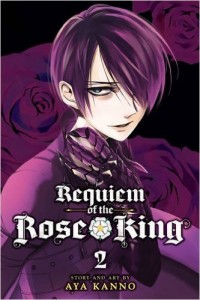Requiem of the Rose King Volume 2 by Aya Kanno
This has been one of the manga series that I’ve been anticipating very impatiently, I enjoyed the first volume very much, and was eager to see how the story would develop in the second volume. Kanno is still in the initial stages of developing the story, but this volume provides more insight into the psychological pressures afflicting the people who rule during the Wars of the Roses.
If Richard didn’t have enough to deal with in the first volume, his situation grows even more unbearable when his beloved father is captured by the House of Lancaster and tortured horribly. Richard is left behind by his family’s army, left alone to deal with the torment of knowing his father has been captured. He crosses a line when he realizes that murder is the only way for him to gain the disguise and weapons he needs to journey behind enemy lines. Richard encounters Henry again when he’s struggling with the emotional aftermath of his actions. While Richard deals with his problems by enduring horrible visions and taking violent action, Henry’s passivity and desire to escape his responsibilities serves as a strong contrast to Richard’s more decisive nature. While Richard is clearly heading down a path of madness and despair, it also seems like his actions are going to have a strong impact on the world around him. Henry just wants to withdraw and allow his insane wife Margaret to make all his decisions for him.
When Richard discovers his father’s fate, Kanno’s paneling decisions underscore the emotional impact. Richard’s face is shown with a blank expression with his eyes hidden to underscore the shock he initially feels, followed by single panels showing his whole face, zooming in on his surprised eyes and clenched mouth as he confronts his father’s death. Richard begins a transformation into the monster that people have labeled him as before, as he’s absolutely consumed by the need for vengeance. As the events later in the volume unfold, Richard is portrayed in a more and more stylized fashion, becoming a living embodiment of a curse and less like the tortured human the reader encountered in the first volume.
The emotional stakes have certainly been raised in this volume, and Kanno’s illustration style is really stretched way beyond what I expected from the author of Otomen. There’s certainly more and more tragedy ahead, but Kanno’s take on the story of Richard the Third is a fresh and incredibly interesting adaptation. The tragedy and emotional trauma feels entirely justified and in service to the plot Kanno is developing. If you haven’t checked out this series yet, now is a great time to jump on and read two volumes with no waiting.













 MJ: There’s a lot to choose from at
MJ: There’s a lot to choose from at  MICHELLE: I picked Sailor Moon last week, so I’ll pick something else. Man, there is a lot of good stuff on that list, but like MJ, I am going to have to go with an old favorite.
MICHELLE: I picked Sailor Moon last week, so I’ll pick something else. Man, there is a lot of good stuff on that list, but like MJ, I am going to have to go with an old favorite.  SEAN: Indeed, lots of stuff I could pick, but I keep coming back to
SEAN: Indeed, lots of stuff I could pick, but I keep coming back to 













 First, this week I finally sat down with volume one of
First, this week I finally sat down with volume one of  MICHELLE: Yes, though I think I will save the manga that pleased me most for my second pick and instead talk about volume two of
MICHELLE: Yes, though I think I will save the manga that pleased me most for my second pick and instead talk about volume two of  MJ: Well, you know I’ve been on a Keiko Kinoshita kick lately—a minor addiction that’s been primarily enabled by the Digital Manga Guild, which has been licensing her works left and right. Though I’m admittedly disappointed that I won’t be able to collect these in print, there is something pretty satisfying about being able to make an impulse purchase online and find myself reading the book on my iPad seconds later, which is what I did earlier this week with
MJ: Well, you know I’ve been on a Keiko Kinoshita kick lately—a minor addiction that’s been primarily enabled by the Digital Manga Guild, which has been licensing her works left and right. Though I’m admittedly disappointed that I won’t be able to collect these in print, there is something pretty satisfying about being able to make an impulse purchase online and find myself reading the book on my iPad seconds later, which is what I did earlier this week with  MICHELLE: I am! That’s because
MICHELLE: I am! That’s because  MICHELLE: Some very enjoyable things! First up is the third volume of
MICHELLE: Some very enjoyable things! First up is the third volume of  MJ: My first selection for the evening is a very different brand of shoujo than Sailor Moon, though also quite enjoyable. I’m speaking of the first volume of Miyoshi Tomori’s
MJ: My first selection for the evening is a very different brand of shoujo than Sailor Moon, though also quite enjoyable. I’m speaking of the first volume of Miyoshi Tomori’s  MICHELLE: Well, speaking of nuanced characters… I read volume two of
MICHELLE: Well, speaking of nuanced characters… I read volume two of  MJ: My second read this week is the perfect example of everything Wandering Son is not. That would be Hisaya Nakajo’s
MJ: My second read this week is the perfect example of everything Wandering Son is not. That would be Hisaya Nakajo’s